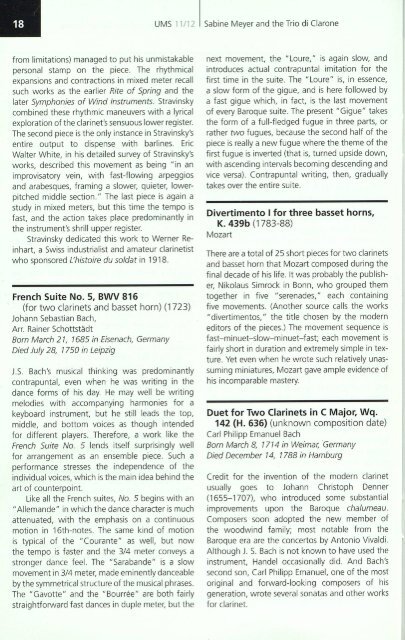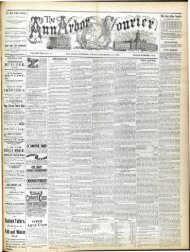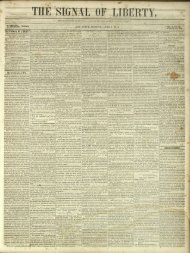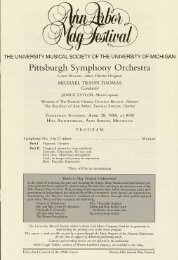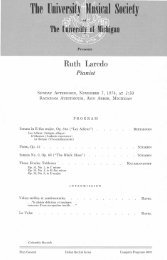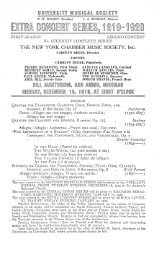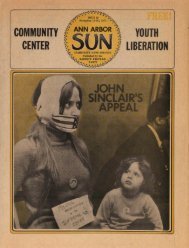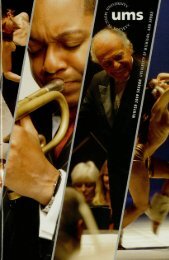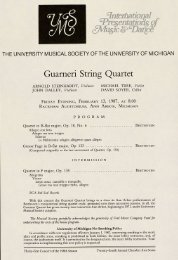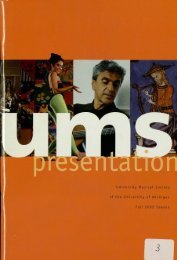University Musical Society - Ann Arbor District Library
University Musical Society - Ann Arbor District Library
University Musical Society - Ann Arbor District Library
Create successful ePaper yourself
Turn your PDF publications into a flip-book with our unique Google optimized e-Paper software.
from limitations) managed to put his unmistakable<br />
personal stamp on the piece. The rhythmical<br />
expansions and contractions in mixed meter recall<br />
such works as the earlier Rite of Spring and the<br />
later Symphonies of Wind Instruments. Stravinsky<br />
combined these rhythmic maneuvers with a lyrical<br />
exploration of the clarinet's sensuous lower register.<br />
The second piece is the only instance in Stravinsky's<br />
entire output to dispense with barlines. Eric<br />
Walter White, in his detailed survey of Stravinsky's<br />
works, described this movement as being "in an<br />
improvisatory vein, with fast-flowing arpeggios<br />
and arabesques, framing a slower, quieter, lower-<br />
pitched middle section." The last piece is again a<br />
study in mixed meters, but this time the tempo is<br />
fast, and the action takes place predominantly in<br />
the instrument's shrill upper register.<br />
Stravinsky dedicated this work to Werner Re-<br />
inhart, a Swiss industrialist and amateur clarinetist<br />
who sponsored L'histoire du soldat in 1918.<br />
French Suite No. 5, BWV 816<br />
(for two clarinets and basset horn) (1723)<br />
Johann Sebastian Bach,<br />
Arr. Rainer Schottstadt<br />
Born March 21, 1685 in Eisenach, Germany<br />
Died July 28, 1750 in Leipzig<br />
J.S. Bach's musical thinking was predominantly<br />
contrapuntal, even when he was writing in the<br />
dance forms of his day. He may well be writing<br />
melodies with accompanying harmonies for a<br />
keyboard instrument, but he still leads the top,<br />
middle, and bottom voices as though intended<br />
for different players. Therefore, a work like the<br />
French Suite No. 5 lends itself surprisingly well<br />
for arrangement as an ensemble piece. Such a<br />
performance stresses the independence of the<br />
individual voices, which is the main idea behind the<br />
art of counterpoint.<br />
Like all the French suites, No. 5 begins with an<br />
"Allemande" in which the dance character is much<br />
attenuated, with the emphasis on a continuous<br />
motion in 16th-notes. The same kind of motion<br />
is typical of the "Courante" as well, but now<br />
the tempo is faster and the 3/4 meter conveys a<br />
stronger dance feel. The "Sarabande" is a slow<br />
movement in 3/4 meter, made eminently danceable<br />
by the symmetrical structure of the musical phrases.<br />
The "Gavotte" and the "Bourree" are both fairly<br />
straightforward fast dances in duple meter, but the<br />
UMS Sabine Meyer and the Trio di Clarone<br />
next movement, the "Loure," is again slow, and<br />
introduces actual contrapuntal imitation for the<br />
first time in the suite. The "Loure" is, in essence,<br />
a slow form of the gigue, and is here followed by<br />
a fast gigue which, in fact, is the last movement<br />
of every Baroque suite. The present "Gigue" takes<br />
the form of a full-fledged fugue in three parts, or<br />
rather two fugues, because the second half of the<br />
piece is really a new fugue where the theme of the<br />
first fugue is inverted (that is, turned upside down,<br />
with ascending intervals becoming descending and<br />
vice versa). Contrapuntal writing, then, gradually<br />
takes over the entire suite.<br />
Divertimento I for three basset horns,<br />
K. 439b (1783-88)<br />
Mozart<br />
There are a total of 25 short pieces for two clarinets<br />
and basset horn that Mozart composed during the<br />
final decade of his life. It was probably the publish<br />
er, Nikolaus Simrock in Bonn, who grouped them<br />
together in five "serenades," each containing<br />
five movements. (Another source calls the works<br />
"divertimentos," the title chosen by the modern<br />
editors of the pieces.) The movement sequence is<br />
fast-minuet-slow-minuet-fast; each movement is<br />
fairly short in duration and extremely simple in tex<br />
ture. Yet even when he wrote such relatively unas<br />
suming miniatures, Mozart gave ample evidence of<br />
his incomparable mastery.<br />
Duet for Two Clarinets in C Major, Wq.<br />
142 (H. 636) (unknown composition date)<br />
Carl Philipp Emanuel Bach<br />
Born March 8, 1714 in Weimar, Germany<br />
Died December 14, 1788 in Hamburg<br />
Credit for the invention of the modern clarinet<br />
usually goes to Johann Christoph Denner<br />
(1655-1707), who introduced some substantial<br />
improvements upon the Baroque chalumeau.<br />
Composers soon adopted the new member of<br />
the woodwind family; most notable from the<br />
Baroque era are the concertos by Antonio Vivaldi.<br />
Although J. S. Bach is not known to have used the<br />
instrument, Handel occasionally did. And Bach's<br />
second son, Carl Philipp Emanuel, one of the most<br />
original and forward-looking composers of his<br />
generation, wrote several sonatas and other works<br />
for clarinet.


